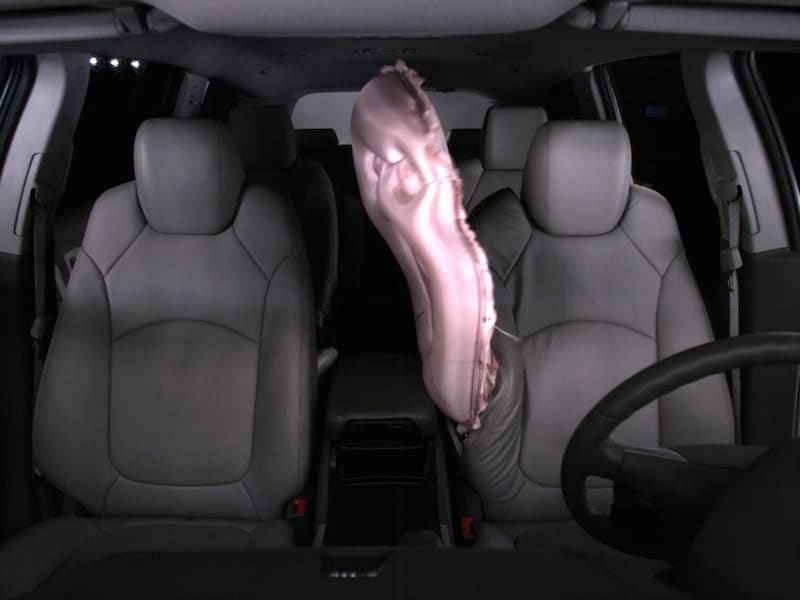Recent Articles
Popular Makes
Body Types
How Do Airbags Work?

Airbags have been in the news recently, partly because of the Takata airbag recall (which appears to be about to expand significantly in scope), and also because of a GM ignition switch recall to fix an issue that can lead to the airbags not functioning in a crash (as well as a loss of engine power, which can also lead to a loss of power steering). Pretty much everyone knows that properly functioning airbags can save lives, but not everybody knows exactly how they work (or what can cause them to fail).
Almost instantly after a crash occurs, sensors on the front of the car detect an impact and send a signal to the airbag computer. The computer uses the data from the sensors to determine the severity of the crash, and if it determines that they are necessary, commands the deployment the airbags. This part of the process takes only 10 or 20 milliseconds (one to two hundredths of a second).
When the airbag receives the command to deploy, a chemical reaction is started when the sodium azide (NaN3) inside the airbag is heated by the ignitor. When the NaN3 is heated, the bonds holding the molecule together are broken, causing the nitrogen to be released and expand quickly, inflating the airbag (only a small amount of the sodium azide is needed to inflate the airbag). The leftover sodium (Na) is reactive and could be dangerous, so a secondary reaction with potassium nitrate (KNO3) creates potassium oxide (K2O), sodium oxide (Na2O), and more nitrogen (N2). A third and final reaction adds in some silicon dioxide (SiO2) which mixes with the K2O and Na2O to create what is essentially glass. All of this takes around 20 or 30 milliseconds, and happens within four or five hundredths of a second from the beginning of the impact.
The airbag can travel at over 125 miles per hour as it inflates. This is normally quite safe, but can be a problem if you or the other front seat occupant is too close when it goes off, which is why it is recommended to sit as far away from the airbag as comfortably and safely as possible, and most importantly, to buckle up your safety belt. The Takata airbags were recalled because of a design problem that causes them to be susceptible to deterioration, especially when exposed to moisture and high humidity, which could lead to the airbags deploying with too much force. If the force is too great, it can damage the inflator’s housing and send shrapnel flying, potentially injuring passengers.
Once inflated, the airbag can do its job of protecting the occupant. It does this by slowing down the rate of deceleration, increasing the amount of time it takes for your body to come to a stop. The passenger’s momentum normally starts being absorbed by the airbag around six hundredths of a second after the crash, and will continue to be cushioned for another 60 milliseconds. The airbag can also help cushion the occupant from interior objects such as the steering wheel or dash. Airbags work best with occupants who have fastened their seatbelts, but are designed to work with unbelted occupants as well.

Since 1998, the National Highway Traffic Safety Administration (NHTSA) has required depowered second generation airbags for both the driver and passenger. Since then, airbags have become more common for other positions as well, including side torso airbags, side curtain airbags, knee airbags, and even seat belt airbags, though not all use the same method of inflation. While Takata is probably the most well known manufacturer of airbags at the moment, other manufacturers include Delphi, KSS, and TRW.
Depending on the model of the automobile, the airbags may have an expiration date, or may be good for the lifetime of the vehicle. If your airbag diagnostic light is flashing, you should repair the problem as soon as possible to ensure that the supplemental restraint systems work as expected. You may be able to determine the problem by counting the pattern of flashes or by having the codes read, and then searching online. The most common airbag problems are caused by broken clocksprings in the steering column (clocksprings are used to transfer power and signals through the steering column to the steering wheel), frayed or disconnected wiring, malfunctioning occupant sensors, or airbag computer problems. Before doing any work on any part of the airbag system, be sure to consult a repair manual for your specific vehicle for special instructions. At the very least, they will most likely call for the negative battery to be disconnected, perhaps for an extended period of time, before work can be performed.

To help keep yourself (and your occupants) safe when driving, keep a separate keyring with only your ignition key on it (it might be a good time to make yourself a backup key as well), sit as far away from the airbag as possible, avoid using a rear facing child seat in the front seat of vehicles equipped with passenger air bags (and ensure that child seats are secured correctly), keep your vehicle properly maintained (including airbag systems, brakes, tires, steering, and suspension, as well as keeping abreast of any recalls), buckle up (and ensure that your seatbelts are in good shape, and not frayed or damaged), and remember to drive safely and without distractions.
For more information on how airbags work, you can visit Takata’s informational page (with an animation) at http://www.takata.com/en/around/airbag01.html.
